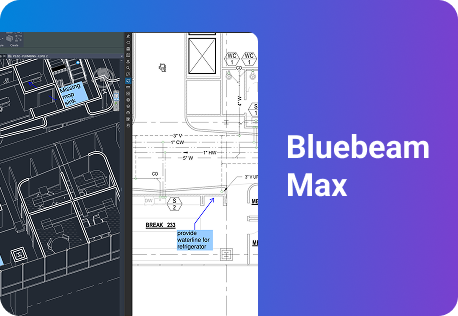Ask David Garrigues, Kimley-Horn’s head of production applications, how the firm originally used Bluebeam, and he doesn’t hesitate:
“We were probably like a lot of firms—using Bluebeam for the basics. We viewed it as a really good PDF tool, and that was it.”
Back in the early 2010s, adoption was informal and organic. Engineers and designers across the firm’s many offices preferred Bluebeam for marking up plans and editing PDFs, but there were few shared standards. Templates, custom tools and more advanced features remained localized.
“It was grassroots,” Garrigues said. “Pockets of people were doing interesting things with it, but it wasn’t formalized or widely adopted.”
Even so, the seeds of possibility were there. Increasingly, more teams were asking for Bluebeam access. A few teams used Studio Sessions for distributed reviews. Some experimented with batch tools and stamps. But without better coordinated internal support, the software’s broader potential remained untapped.
Today, Bluebeam is embedded across Kimley-Horn’s national operations, with nearly 8,000 subscriptions supporting collaboration across hundreds of active projects. The software has become an integral part of the firm’s digital infrastructure.

A Pandemic Turns the Tide
Everything changed in 2020.
“Among many examples, one team had a major deadline, and we had to get through a 600-page QA/QC set, with three offices, five engineers and no one in the same place,” Garrigues recalled. “Studio Sessions saved us.”
With offices closed and projects still moving, Bluebeam quickly became mission critical. Instead of teams relying on marking up plans by hand and sending PDF scans to each other, QA/QC coordination transformed into a shared digital space of Bluebeam Studio, with real-time comments, version tracking and full transparency.
“We needed a digital tool we could trust; that we already had; that could scale quickly,” added Mark Bishop, senior vice president and production manager. “Bluebeam became that tool.”
Scaling with Intention
The firm’s Bluebeam evolution followed a natural, phased maturity curve:
- Early Use (2010s): PDF markup, ad hoc use, no formal support
- Organic Growth (2017–2019): Power users build templates, teams try Studio
- Pandemic Inflection Point (2020): Rapid expansion and adoption to support remote QA/QC
- Customization and Standardization (2021–2022): Training, shared tools, internal champions
- Strategic Partnership (2023–Today): Embedded support and joint planning
“Bluebeam’s Customer Success Manager is part of our team. He meets with us regularly, helps us identify areas for improvement and brings product feedback directly to engineering.”
David Garrigues
Head of Production Applications,
Kimley-Horn
From 2016 to 2024, Kimley-Horn increased its Bluebeam seats by more than 240% across its 100 offices. This growth happened organically, driven by team needs and peer influence rather than top-down mandates.
This rapid growth reflects a shift from ad hoc usage to a fully integrated collaboration tool supported by formal training and internal champions.
“The grassroots activities became more intentional,” Garrigues said. “Once we saw how critical Bluebeam was, we had to support it properly.”
That support included building out a network of internal Bluebeam champions, offering formal training and launching quarterly power-user meetings.
These meetings, led by John Armendariz, senior production applications manager, became an essential forum for knowledge-sharing and surfacing feedback from across the company.
Studio Sessions: The Game Changer
While many Bluebeam features gained traction, Studio Sessions stood out.
“We found quickly that Bluebeam could be much more than just a PDF viewer and editor,” Bishop said. “It could become a communication and quality tool.”
For teams working across offices and disciplines—transportation, utilities, development services, traffic planning and operations—real-time commenting and markup threads became the backbone of technical dialogue.
No more “version chaos.” No more “who said what.” Just shared visibility, in context, every time.
Training That Works—Because It’s Local
Kimley-Horn didn’t push change as a firm-wide mandate. Instead, it looked to those already helping their peers.
“What works best at Kimley-Horn is finding critical mass and leaning into where our clients and our teams are going,” Bishop said. “We sought out our people who were experimenting and asking for new templates and new features—those became our Bluebeam champions.”
That peer-based model helped drive fast adoption without resistance. New features and workflows spread naturally, supported by internal leaders who understood each team’s specific needs.
The firm also integrated Bluebeam into its IT help desk, creating internal documentation, processes and ticketing support tailored to engineering workflows. Custom internal documentation and engineering-specific ticketing workflows made support scalable and effective.
“It’s not just a software we have. It’s something we truly support internally,” Garrigues said.

Focused on What Matters
One reason Bluebeam stuck: It didn’t try to be everything.
“There are complicated platforms out there that want to be your project manager, your design tool, your asset tracker,” Bishop said. “Bluebeam doesn’t try to do that. It focuses on being great at review and collaboration.”
That clarity of purpose resonated across disciplines. Instead of overwhelming users with bells and whistles and an inflexible software design, Bluebeam delivered a streamlined experience focused on what mattered most to engineers: precise markups, real-time feedback, some customization and intuitive tools that mirrored the way they already worked.
This made onboarding simpler, especially for interns and new hires. It also enabled Kimley-Horn to encourage teams to build consistent workflows across their specialties, leaving room for flexibility at the office level.
The result: Bluebeam wasn’t just easier to adopt but easier to trust. From conceptual planning to QA/QC and final delivery, the tool supported every stage of the project lifecycle without trying to replace the firm’s broader tech stack.
That laser focus turned Bluebeam into a foundational layer for collaboration, not just another software box to check.
A True Partner, Not Just a Vendor
As Kimley-Horn matured its use of Bluebeam, the relationship with the company itself evolved.
“We’ve had regular conversations with Bluebeam’s team about our needs, especially as we’ve scaled,” Garrigues said. “They’ve been really responsive.”
In fact, Bishop now serves on Bluebeam’s Customer Advisory Board (CAB)—a role that helps ensure enterprise users like Kimley-Horn have a voice in influencing future innovations.
That responsiveness translated into:
- Tailored training and onboarding
- Engineering-specific documentation
- Expansion of outreach to universities and colleges
- Product roadmap discussions and feature feedback
- Dedicated support channels through Bluebeam’s Customer Success team
“It’s the difference between a product we use and a company we trust,” Bishop said.
“Bluebeam’s Customer Success Manager is part of our team,” Garrigues added. “He meets with us regularly, helps us identify areas for improvement and brings product feedback directly to engineering. That’s been key.”

Looking Ahead: Measuring What Matters
With strong adoption and support in place, Kimley-Horn is now shifting focus from rollout to optimization.
“There’s still so much we can do,” Garrigues said. “We’re very excited to explore integrations. We’re looking at metrics. We want to understand how Bluebeam further improves efficiency—and, in turn, results in excellent client service.”
From dashboarding to digital deliverables, the firm is exploring how Bluebeam can fuel smarter decision-making and measurable ROI across client engagements.
“At some point, our use of Bluebeam stopped being about the software,” Garrigues said. “It became about how we work as a company.”
“Tools only work when they get used,” Bishop added. “Then notable change comes from connecting that tool to your company’s greatest needs.”




